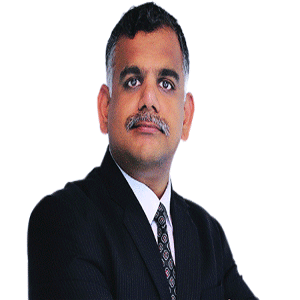THANK YOU FOR SUBSCRIBING

Virtualization and the New Dawn of Data Security in APAC
Ajay Sunder, VP-Digital Transformation, Frost & Sullivan


Ajay Sunder, VP-Digital Transformation, Frost & Sullivan
The importance of standards
Data Center industry has gone through lot of changes in the last couple of years; data centers have become more complex, difficult to operate and energy guzzlers. These problems are not only faced by the enterprises, but also by the government entities globally. Many governments in Asia Pacific have started implementing their broadband plans and are also focusing on modernizing the ICT infrastructure for public entities. Data Centers being part of ICT infrastructure also are on list of getting modernized and governments are looking at making these data center energy efficient. Governments have also realized that data centers have become enablers for all the e-government services and modernizing them would help smooth delivery of government services. As part of the modernization initiative, governments around Asia Pacific are looking to adopt international standards as part of modernization process.
The internet traffic is increasing at a very fast pace and is driving the data storage for government as well as enterprises, which is resulting in continuous expansion of the data center. Increased number of web and mobile application are being developed and used and this is driving demand for web space. The advent of newer technologies such as data analytics, big data, Internet-of-Things, etc. is increasing the amount of data that is collected and stored. World’s biggest technology organizations (for example, Microsoft, Google, IBM, and Cisco) have taken on the development of smart cities for which the data centers would become an enabler for these smart cities. Fueled by these factors among others, the global data centers industry is expected to grow across the world.
Data centers operate 24/7 and are highly energy intensive, the energy intensity of a data center may be 10 to 100 times of a typical commercial building. Rising energy prices are also increasing the operating cost of data centers and it has been reported that global data center carbon emissions will grow 7 percent year-on-year through 2020. It is estimated that achieving just half of the technologically feasible savings through adopting best practices could cut electric use by 40 percent in data centers.
To enable effective management and provisioning of services in the dynamic environment, standards play a role in recommending practices and performance requirements and thereby provide a framework for best practices.
Paradigm shift in the role of IT
A sense of urgency is being felt as CEOs face the consequences of digital transformation. From an IT perspective, it is creating an era of unprecedented changes. The IT function is now partnering with the business to enable achievement of business objectives, provide technology framework to ensure compliance and governance, as well as maximize the opportunities from digital technologies.
It is estimated that achieving just half of the technologically feasible savings through adopting best practices could cut electric use by 40 percent in data centers
The role is thus is evolving from being operational to more strategic with an expected ability to offer guidance across business units to help them define, develop and deploy innovative digital business applications. To provide the competitive advantage, IT organizations will thus need to be early adopters of new technologies and invest in infrastructure that enables implementation, governance and support for these advanced technologies.
The core of the new Hybrid IT
While the benefits offered by public cloud architectures are attractive for most organizations and there are companies willing to host their workloads in third party data centres, there are also companies that intend to retain full ownership and control of the IT infrastructure.
Thus, to create an IT environment that offers the optimal infrastructure environment, optimizes IT investments, and accommodates a variety of workloads, enterprises are deploying a hybrid type of IT infrastructure and services architecture.
Hybrid IT is expected to be the optimal IT deployment model and is the answer to building the right mix of private cloud, public cloud, managed cloud and traditional IT infrastructure, which is unique to the organization. Hence a large number of enterprises are expected to integrate different infrastructures, from multiple providers, under a single, common management platform.
Given the fact, that Hybrid IT environment is based on unique needs of the organization, the best–fit architecture could vary extensively across organizations. The mix of on premise, off premise, managed and outsourced workloads is contextual, making the Hybrid IT architecture and its definition being contextual.
There are 3 key elements for a Hybrid IT landscape:
1. improves the alignment between IT services and business objectives.
2. It is a mix of physical and virtual infrastructure services enabled by a software defined layer over the traditional infrastructure ( Network, Data centre, WAN)
3. Can be hosted in both on- and off-premise environments
Security: The elephant in the room
Data is critical to enterprises; monitoring the access permissions and protecting it will continue to be of prime importance. While enterprises will need to make continual investments in security, moving the data into the cloud, enterprises will lose some capabilities to govern its own data set. Managing security thus demands an all-inclusive approach of technology, people, and policy. Enterprises cannot train personnel to optimize the use of all security capabilities at their disposal, or manage the security policies from a holistic perspective. Given this fact that there is a need to remodel the security landscape and there will be perpetual scope to improve security efficacy through design, enterprises are increasingly relying on the service providers to guarantee the safety of their data.
The Last Word
• Hybrid IT leverages both on-premise and cloud environments to give enterprises optimum benefits. The advantages are clear and the best solution for managing workloads that have specific security or compliance requirements with workloads that have large variances in demand.
• One size-fit all IT strategy will not work. Digital Transformation is a journey and enterprises will be at varying stages of the maturity curve. The uniqueness of business needs will demand varying IT architectures and thereby a solution led approach by service providers and technology partners.
• Access to underlying infrastructure at the lowest possible cost will still be important to enterprises. But will be important to have a software defined layer to enable enterprise CIOs to have visibility of the various elements (on-premise as well as Cloud).












